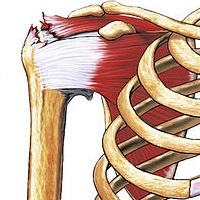
Photo from wikipedia
Several trials have been carried out to improve the healing of rotator cuff tear, but their effects remain controversial. In this study, we examined the therapeutic effect of platelet‐rich plasma… Click to show full abstract
Several trials have been carried out to improve the healing of rotator cuff tear, but their effects remain controversial. In this study, we examined the therapeutic effect of platelet‐rich plasma (PRP) in combination with self‐assembled peptide (SAP) on the healing of rotator cuff tear in the rat. Twenty‐seven Sprague–Dawley rats, aged 15 weeks, were used for the rotator cuff tear model. The supraspinatus muscle at the insertion site was dissected and truncated, leaving the cut edge free. A week after the surgery, the rats were randomly divided into SAP, PRP, SAP–PRP and control groups and 0.2 ml SAP, PRP, SAP–PRP and saline were injected, respectively. Bonar scores and synovial inflammation grade were checked 5 weeks after the injection. Immunofluorescence staining for heat shock protein (HSP)‐70 and caspase‐3 was conducted. Furthermore, maximum stride length was measured before and at 2 and 4 weeks after the injection. The Bonar scores were 6.4 ± 1.8 in the SAP group, 5.9 ± 2.0 in the PRP group, 4.7 ± 1.1 in the SAP–PRP group and 8.3 ± 2.3 in the control group. There was significant difference between the SAP–PRP and control groups in post hoc multiple comparison analysis. Among four categories of Bonar scores, collagen arrangement and vascular infiltration showed improvement after SAP–PRP injection. Immunofluorescence images showed that HSP‐70 and caspase‐3 were much less expressed in the SAP–PRP group than in the other groups. In conclusion, SAP–PRP can be effective in healing a rotator cuff tear by enhancing the collagen arrangement and inhibiting inflammatory changes and apoptosis. Copyright © 2015 John Wiley & Sons, Ltd.
Journal Title: Journal of Tissue Engineering and Regenerative Medicine
Year Published: 2017
Link to full text (if available)
Share on Social Media: Sign Up to like & get
recommendations!